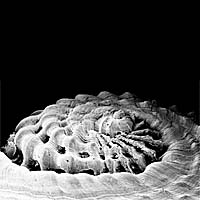|
< Previous family introduction |
|
|||||
 |
Family Vanikoridae Vanikoros
|
|||||
|
This is a small family of unusual gastropods, found both in tropical and temperate waters. The tropical Australian species are moderately large, up to about 30 mm in height, but the southern Australian species are small or minute. The tropical species live intertidally or in the shallow subtidal hidden under embedded rocks; the habitat of the southern species is unknown, but empty shells are found from beach level down to about 100 metres. The shells of this family are unusual in that early sculpture is quite different to that of the mature shell. The first teleoconch whorl is usually sculptured with strong lamellae, ribs or cords, or a combination of these, which fades away on the adult shell. In one of the NSW species the sculpture goes through three distinct phases, making juvenile shells quite difference in appearance to the adults. The animals in this family have well developed tentacles and a short snout. In some genera the animals are mobile, but in Vanikoro they are sedentary, and detached animals are apparently unable to reattach to the substrate. They are probably consecutive hermaphrodites, male first changing to female. They are sometimes found in pairs, with a larger female and a smaller male. The diet is not known, but the sedentary species must be restricted to passing algae or detritus, or perhaps surrounding algae or bacteria. The family is poorly known taxonomically. There has been no revision of the family since that of E.A. Smith in 1908 (see below), and even that was without figures, referring to earlier illustrations. Most of the species of Vanikoro were described in the 19th century and relied heavily on adult shell sculpture, spire height and umbilicus shape, but the most useful character for separating the species is early shell sculpture, which was usually not detailed or figured. Consequently, the names in use for species of Vanikoro in the Indo-West Pacific and Australian literature are confused, and will remain so until a thorough revision of the genus is presented. Three genera of this family occur in NSW, including Couthouyia, which is only tentatively placed here. There are three species of Vanikoro, two of which have a tropical Indo-West Pacific distribution, and one with a southern Australian distribution. There are four species of Naricava, with south-eastern or southern Australian distributions, and one minute, rare species of Couthouyia Family References There is no modern treatment of the whole family. The most recent revision, which has no figures, is:
The taxonomy of some of the Indo-West Pacific species is covered by:
All the known species of the family that occur in NSW are detailed here. Wilson (1993) lists Vanikoro gueriniana (Potiez & Michaud, 1838) from NSW. His figure (Wilson, 1993, Pl. 22, Fig. 15) , is of a specimen from the Australian Museum, registered number C.007563. The is the only Australian specimen of 15 lots of the species in the Museum collection, and is very likely mislocalised. Identification Notes Apart from the minute, rare species of Couthouyia, the rest of the NSW species have globose shells with a large aperture and a widely open umbilicus, and are white in colour.
|